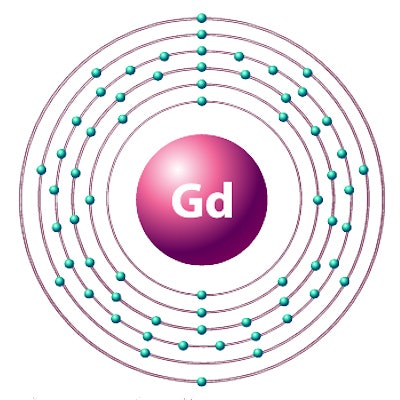
Only trace amounts of the gadolinium administered to pregnant monkeys cross the placenta and enter the fetuses, and most of this gadolinium quickly returns back to the mother's bloodstream for excretion, according to research published in the January issue of Radiology.
As part of an ongoing investigation, researchers from Oregon Health and Science University tracked the levels of the gadolinium-based contrast agent (GBCA) gadoteridol in pregnant rhesus macaques and their babies after performing contrast-enhanced MRI. The group led by Dr. Joao Prola-Netto found that nearly all the gadoteridol that flowed into fetal tissue through the placenta ultimately went back to the mother within 19 to 21 hours -- leaving mostly undetectable levels of gadoteridol in the babies after birth (Radiology, January 2018, Vol 286:1, pp. 122-128).
"The rapid and almost complete clearance [of gadoteridol] from fetal tissues, combined with low levels of dechelation, is reassuring regarding risk during pregnancy," the study authors wrote. "However, long-term effects of such low levels of gadolinium deposition are still unknown."
Crossing the placenta
The relentless controversy over gadolinium deposition becomes especially sensitive in cases of pregnancy. Although no teratogenic consequences have been reported in fetuses among the few studies conducted, hesitation to include gadolinium in MRI protocols for childbearing patients persists, according to the authors.
In prior research, Prola-Netto and colleagues discovered that only a limited amount of gadoteridol actually transferred from pregnant monkeys to their fetuses through the placenta, which the fetuses then excreted into the amniotic fluid. If prolonged, subsequent recirculation of gadoteridol back into fetal tissue could potentially lead to health complications.
With this concern in mind, the researchers sought to shed light on the flow of gadoteridol administered during pregnancy by performing two MRI exams on each of 10 pregnant rhesus macaque monkeys. The first MRI exam took place on day 85 of gestation, which is equivalent to the second trimester of pregnancy, and the second exam on gestational day 135, or early in the third trimester.
For the exams, the researchers introduced gadoteridol (ProHance, Bracco Imaging) into the cephalic vein of each monkey at a dose of 0.1 mmol per kilogram of maternal weight. They then performed whole-body dynamic contrast-enhanced MR imaging (Magnetom Trio, Siemens Healthineers) including a T1-weighted 3D gradient-recalled echo sequence.
The group examined the trace amount of gadolinium that entered the amniotic fluid after the first MRI exam and found that by 50 days it had dropped fourfold to an average concentration of 0.028 x 10-5% of the maternal injected dose detected per gram of fetal tissue.
"This clearly indicates that gadoteridol is transferred from the fetal circulation back to the maternal bloodstream," the authors wrote. In other words, "after gadoteridol undergoes transplacental transfer to the fetus, it is almost completely cleared."
Mostly undetectable
Seven months after the 10 young monkeys were born, the researchers drew their blood and collected tissue samples from the brain, cerebellum, liver, kidney, spleen, lung, femur, and skin. They then measured the gadolinium levels in each sample using inductively coupled plasma mass spectrometry.
Gadolinium levels cleared to undetectable limits in the majority of the fetal tissue samples. Consistent amounts of trace gadolinium were present only in the femur (with a mean of 2.5 x 10-5% of maternal injected dose per gram of fetal tissue) and liver (0.15 x 10-5%). And only one tissue sample of the skin, spleen, brain, and kidney in three monkeys had measurable levels of gadolinium.
"Extremely low levels of gadolinium are found in juvenile macaque tissues after in utero exposure to two doses of gadoteridol, indicating that a very small amount of gadolinium persists after delivery," the authors wrote.
The small population of the study and also the tissue collection being restricted to particular regions and not the entire organs limit these findings, the authors noted. Moreover, the group did not examine the potential impact of gadolinium deposition during the first trimester of pregnancy.
"Given the similarities between human and nonhuman primate placental physiology, we suggest there could be relatively little deposition in human fetal tissues after maternal gadoteridol injection," they wrote. "However, long-term effects of these low doses are unknown."



.fFmgij6Hin.png?auto=compress%2Cformat&fit=crop&h=100&q=70&w=100)




.fFmgij6Hin.png?auto=compress%2Cformat&fit=crop&h=167&q=70&w=250)











